Meat Science and Nutrition
Composition of Meat
Meat muscle, which is what we eat, is made of fibres, bound together with connective tissue, that are mainly linked to other groups of muscles or directly to the animal’s bone structure. Muscle contains 60% to 70% moisture, 10% to 20% protein, 2% to 22% fat, and 1% ash, depending on type and species.
On larger bones (such as the shanks of larger animals), it is easy to see the muscle groups in bundles (if cut on the cross-section) surrounded by collagen fibres and a much heavier connective tissue (elastin) that forms a thin covering (called silverskin) separating muscle groups or a tendon at the ends of the muscle group (Figure 1). The tendon is attached to the bone at or near a bone joint (Figure 2).
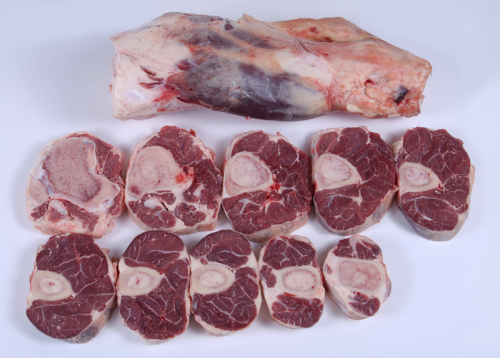
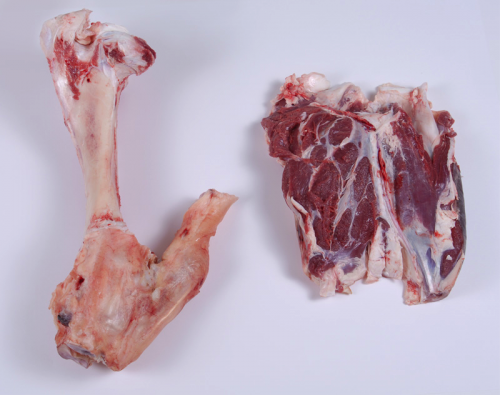
The muscle fibres are known as myofibrils, which are composed of thick and thin filaments arranged in a repeating pattern alongside the other myofibrils (Figure 3). One unit of a bundle is called a sarcomere, or little muscle. The thick filaments are the contractile protein myosin. The thin filaments, known as actin, contain two other proteins called troponin and tropomyosin that help regulate muscle contraction.
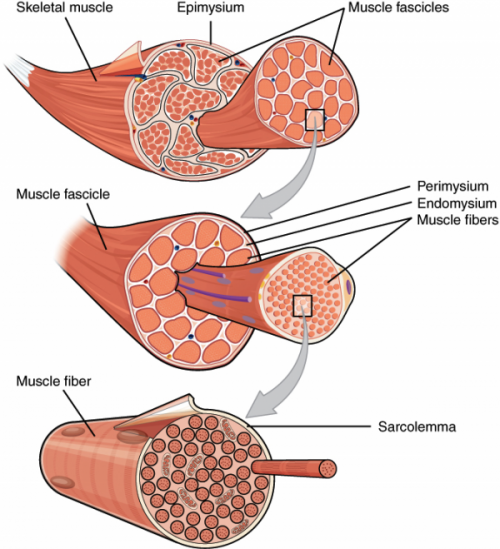
The amount of connective tissue in meats and its solubility (the degree to which it is dissolved during the cooking process) can directly influence the tenderness of meat muscle. For example, as an animal ages, it has more connective tissue and therefore experiences cross-linking, an increase in connective tissue that becomes highly insoluble. This is why older animals are usually tougher and younger animals are more tender.
The most tender cuts from a beef animal, such as tenderloin, strip loin, and top sirloin from the beef hind quarter, can be prepared using a dry heat cooking method. In contrast, tougher cuts from the front quarter of beef that have more collagen connective tissue, such as the blade, shoulder, and shank, require a moist heat or combination cooking method, which breaks down collagen into a gelatin form when cooked in water at temperatures of over 80°C (176°F). The collagen dissolves in the water, which is why stocks made from animal bones and connective tissue have body and thicken when cooled. (We discuss cooking potential and tenderness in more detail later in the book.)
Heavy collagen, such as tendons at the ends of muscle groups and the protein elastin, does not break down under this cooking process and is therefore insoluble in water. In addition to silverskin and tendons, there is a specific piece of heavy collagen (also known as the backstrap) that is yellow in colour and located along the upper backbone from the base of the skull to the end of the rib cage in all meat animals (Figure 4).
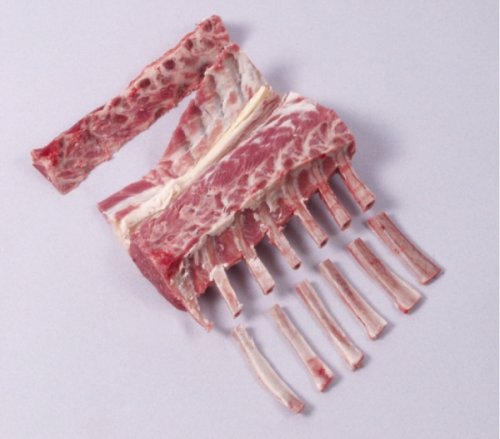
Fats are deposited all over certain parts of the animal and contribute to the shelf life, flavour, and colour of dry aged meats. Fat in beef meat muscle is called intramuscular fat and appears as a pattern of wavy lines, commonly known as marbling (Figure 5).
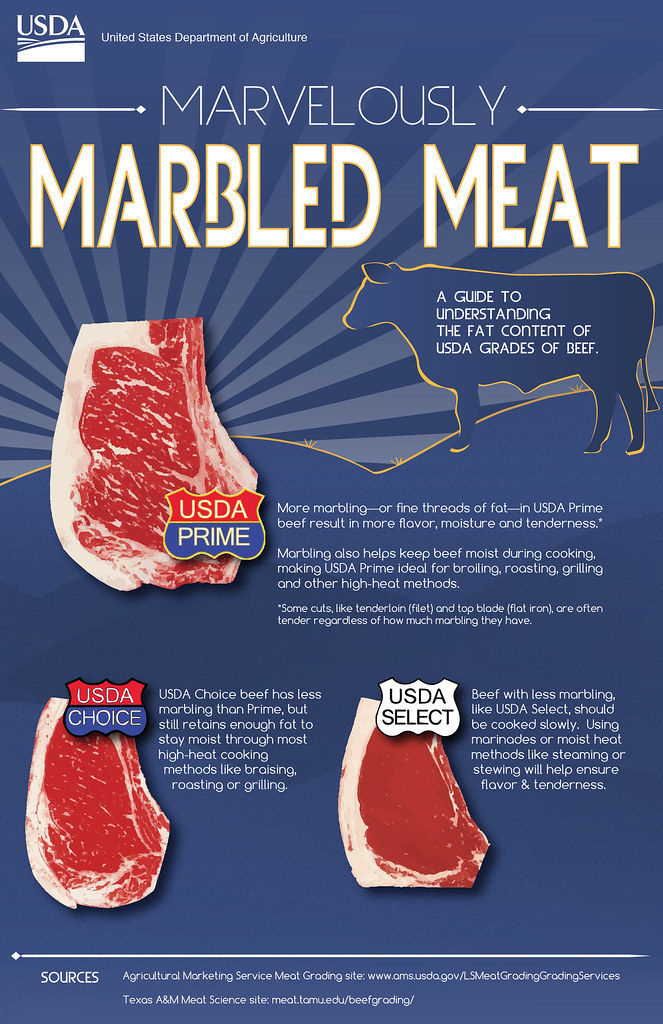
Well-marbled meat usually indicates that the cooked meat will be juicy and tender, and the amount of marbling is a factor that is used to determine the grade of beef, specifically for the A grades. Beef grading is discussed in detail later in the book.
Image descriptions
Figure 5. Poster indicating marbling in USDA Beef grades.
A guide to understanding the fat content of USDA grades of beef.
- USDA Prime: More marbling—or fine threads of fat—in USDA Prime beef result in more flavor, moisture and tenderness. Marbling also helps keep beef moist during cooking, making USDA Prime ideal for broiling, roasting, grilling and other high-heat methods. Some cuts. like tenderloin (filet) crd top uade (flat iron). cre often tender regardless of how much marbling they have.
- USDA Choice: USDA Choice beef has less marbling than Prime, but still retains enough fat to stay moist through most high-heat cooking methods like braising, roasting or grilling.
- USDA Select: Beef with less marbling, like USDA Select, should be cooked slowly. Using marinades or moist heat methods like steaming or stewing will help ensure flavor & tenderness.
Media Attributions
- Crosscut of beef shank © Jakes and Associates is licensed under a CC BY-NC (Attribution NonCommercial) license
- Bone with tendon attached (left) and muscle removed (right) © Jakes and Associates is licensed under a CC BY-NC (Attribution NonCommercial) license
- 1007 Muscle Fibres (large) © OpenStax is licensed under a CC BY (Attribution) license
- Backstrap location on lamb rack © Jakes and Associates is licensed under a CC BY-NC (Attribution NonCommercial) license
- Beef Up Your Knowledge- Meat Marbling 101 © United States Department of Agriculture is licensed under a CC BY (Attribution) license
Filaments of muscle tissue.
A type of connective tissue in meat that dissolves when cooked with moisture and yields gelatin.
A type of connective tissue in meats that does not dissolve when cooked. Commonly known as the backstrap.
A tough connective tissue surrounding muscle; the pearlescent membrane found on certain cuts of meat that is removed before cooking to prevent curling.
Very heavy collagen that forms at the end of muscle groups, such as a beef shank, which joins a muscle group to a bone at or near the exterior of a bone joint.
Muscle fibres composed of bundles of thick and thin filaments arranged in a repeating pattern.
One unit of a bundle of muscle fibres, also called the "little muscle."
The thicker filaments of muscle fibre protein that contract muscles.
The thinner filaments of muscle fibres that help regulate muscle contraction.
A chemical component of actin that assists in regulating muscle contraction (movement).
A chemical component of actin that assists in regulating muscle contraction (movement).
The degree to which a substance can be dissolved in water.
An increase in connective tissue that occurs as animals age.
Cooking methods that use air or hot fat to cook foods, such as baking, frying, and roasting.
Cooking method that uses liquid or steam to cook foods, such as boiling, poaching, and steaming.
Cooking methods that involve both dry and moist heat, such as stewing and braising.
A gelling agent derived from collagen obtained from various animal by-products.
Heavy strip of collagen, yellow in colour, that forms from the top of the spine to the end of the rib cage. Most prominent in beef and lamb carcasses.

